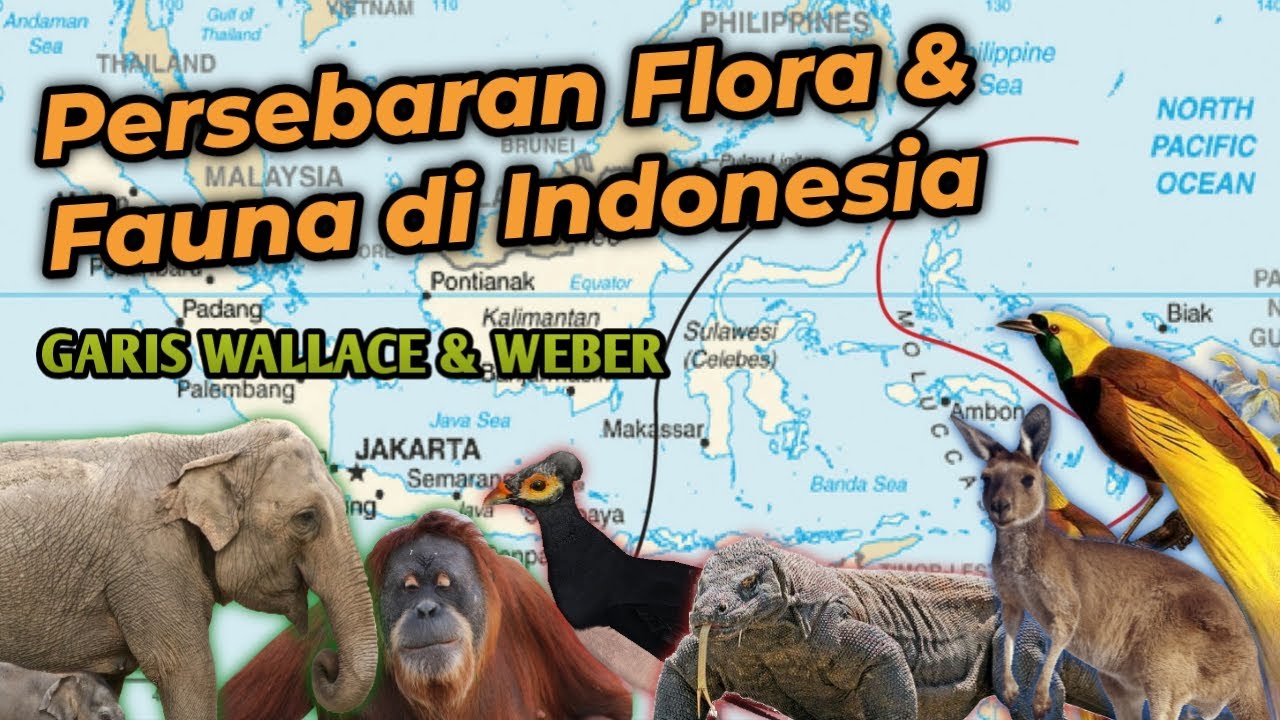GARIS PENGHALANG TAK TERLIHAT YANG MEMISAHKAN DUA DUNIA
Summary
TLDRThe video explores the concept of biogeographical boundaries in Indonesia, specifically focusing on Wallace's Line, which separates distinct animal species between Asia and Australia. It delves into the discoveries of Alfred Russel Wallace, who observed significant differences in wildlife between nearby islands, highlighting the role of tectonic plate movements in shaping biodiversity. The script also discusses other imaginary lines, such as Lydekker's Line and Weber's Line, which further define the ecological zones of the region. Ultimately, it underscores how geological history has profoundly influenced the distribution and evolution of species across the Indonesian archipelago.
Takeaways
- 🌍 Wallace's Line is a significant biogeographical boundary separating distinct animal species in Asia and Australia.
- 🦏 The western side of the line features species like rhinos, elephants, and tigers, while the eastern side has marsupials and unique birds.
- 📜 Alfred Russel Wallace first sketched the line in 1859, observing the differences in biodiversity during his explorations.
- 🔍 The script discusses three major imaginary lines: Wallace's Line, Lydekker's Line, and Weber's Line, each serving different ecological purposes.
- 🌊 Wallace noted that even narrow straits could lead to abrupt changes in animal life, illustrating the concept of ecological barriers.
- 🧪 Wallace's research involved the collection of over 126,000 specimens, significantly contributing to the field of natural history.
- 🗺️ The concept of tectonic plates plays a crucial role in understanding the distribution of species across islands.
- 📈 Geological history has shaped current biological diversity, as many species were previously connected before being separated by rising sea levels.
- 🌱 The biodiversity on either side of Wallace's Line serves as an example of how geography influences species evolution.
- ⚖️ The conclusion emphasizes that human history is shaped more by chance and circumstance than solely by geographic conditions.
Q & A
What is Wallace's Line?
-Wallace's Line is an imaginary boundary that separates the distinct biogeographical regions of Asia and Australia, highlighting the differences in species distribution across Indonesia.
Who first proposed Wallace's Line and when?
-Alfred Russel Wallace first proposed Wallace's Line in 1859 based on his observations during his travels in the Malay Archipelago.
What species are typically found on the western side of Wallace's Line?
-The western side of Wallace's Line is characterized by Asian fauna, including species such as elephants, tigers, and rhinoceros.
What types of species are found on the eastern side of Wallace's Line?
-The eastern side hosts species that are typical of Australia, such as marsupials, the Komodo dragon, and various bird species like cockatoos.
What role did geological history play in the formation of Wallace's Line?
-Geological history played a crucial role, as the islands were once connected by land bridges during periods of lower sea levels, allowing for species migration and distinct evolutionary paths.
What other biogeographical lines are mentioned in the transcript?
-The transcript mentions Lydekker's Line and Weber's Line, which also serve as boundaries distinguishing different fauna and flora in Indonesia.
How did Wallace's research contribute to the theory of natural selection?
-Wallace's extensive collection of species and observations during his travels led him to formulate ideas about natural selection, demonstrating how environmental factors influence species adaptation and distribution.
What was one significant observation Wallace made about species distribution on nearby islands?
-Wallace observed that even closely situated islands could host drastically different species, indicating the presence of invisible barriers affecting wildlife distribution.
How did tectonic plate movements impact the biodiversity in the region?
-Tectonic plate movements have shaped the geological landscape of the region, influencing the distribution and evolution of species by creating new islands and altering land connections.
Why is Wallace's Line still significant to biogeographers today?
-Wallace's Line remains significant because it exemplifies the complex interplay between geology and biology, illustrating how historical events have shaped current biodiversity patterns in the Indonesian archipelago.
Outlines

هذا القسم متوفر فقط للمشتركين. يرجى الترقية للوصول إلى هذه الميزة.
قم بالترقية الآنMindmap

هذا القسم متوفر فقط للمشتركين. يرجى الترقية للوصول إلى هذه الميزة.
قم بالترقية الآنKeywords

هذا القسم متوفر فقط للمشتركين. يرجى الترقية للوصول إلى هذه الميزة.
قم بالترقية الآنHighlights

هذا القسم متوفر فقط للمشتركين. يرجى الترقية للوصول إلى هذه الميزة.
قم بالترقية الآنTranscripts

هذا القسم متوفر فقط للمشتركين. يرجى الترقية للوصول إلى هذه الميزة.
قم بالترقية الآنتصفح المزيد من مقاطع الفيديو ذات الصلة

PERSEBARAN FAUNA DI INDONESIA #geography #education #kurikulummerdeka #flora #fauna

KEANEKARAGAMAN HAYATI DI INDONESIA

The Invisible Barrier Keeping Two Worlds Apart

PENYEBAB INDONESIA PUNYA PULUHAN RIBU JENIS SPESIES FAUNA dari 2 Benua Kisah Indo Purba #4

Keanekaragaman Hayati | Biologi SMA Kelas 10

Garis Wallace dan Weber - Persebaran Flora & Fauna di Indonesia | Dunia Biologi
5.0 / 5 (0 votes)
